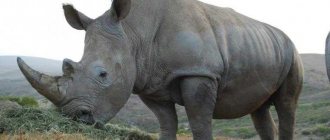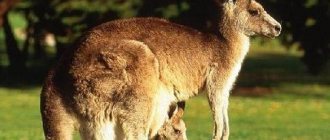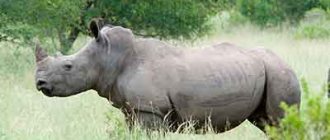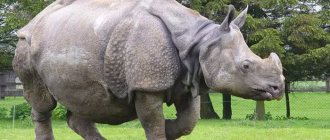Rhinoceros: general characteristics
Rhinoceroses belong to the class of herbivorous equid mammals, and are part of the rhinoceros family. It is noteworthy that, apart from a conditional similarity with elephants and hippos, rhinoceroses have nothing in common with them, but they are distant relatives of horses, tapirs and zebras.
Rhinoceroses are ancient and unique animals
These are truly gigantic animals, whose height can reach from 1.3 to 2.2 m, and their weight ranges from 800 kg to 5 tons. Rhinoceroses have a powerful, squat body and strong, medium-length limbs. The color is usually gray, with a pink, brown or yellowish tint, and only the Sumatran subspecies is brownish-reddish.
The skin of rhinoceroses is thick and rough. The Asian subspecies have pronounced wrinkled folds on the body, and the skin is covered with small bumpy growths. African relatives have smoother skin, and their folds are almost invisible. By the way, although rhinos are considered “thick-skinned,” they are actually very sensitive to sunlight and ultraviolet radiation, and their skin is prone to dryness and inflammation. Therefore, on particularly hot days, these giants are forced to cool off in swampy ponds.
The main distinguishing feature of animals is, of course, their horn. It looks quite menacing and intimidating, but, in fact, for the rhinoceroses themselves it is a useless decoration, because they do not use it as a weapon or to attract the attention of the opposite party.
Rhino horn is not made of bone tissue, but of keratin - the same material as human hair and nails. It grows in animals throughout their lives, and some varieties can reach 1.5 meters in length. But, since animals constantly wear it down on trees, the size of their horns is no more than 20-60 cm.
Rhinoceroses have very poor eyesight, but they have sensitive hearing and an excellent sense of smell. These animals look clumsy, but they are excellent runners, and a frightened or angry rhinoceros can run at a speed of 40-50 km per hour.
Rhinoceroses are considered long-lived, because the African subspecies in the wild live 30-40 years, and their Asian relatives can reach a respectable 70 years of age.
Elena
Ask a Question
Question to the expert
Is it true that employees of parks and reserves cut off the horns of rhinoceroses?
Yes it's true. Veterinarians and zoologists go to such desperate measures so that the animal, having lost its decoration, is of no interest to others. The procedure itself for rhinoceroses is painless, because before cutting off the horns, the animal is euthanized with a tranquilizer.
Appearance
The color of this species of animal is not light, but has the following color range: from light gray to dark straw color, or slightly lighter than black. And all because the British distorted the Boer word, in translation (wide, wide-snouted), which sounded very similar to “light”.
From them the fiction passed into other languages. The weight of the animal reaches 4-4.7 tons, in rare cases up to 5, and on average 2-2.6 tons, and is 4.3 meters long. Height at the shoulders is 1.6-2 m. The skin has almost no hair, it is smooth and very thick. There are two horns of different sizes on the head. The front horn of a white rhinoceros is always longer than the back and measures 150 cm.
Thanks to the first horn, it defends itself and easily gets food for itself in hard-to-reach thickets, pushing them aside. The legs are well developed, thanks to them it can quickly develop speed. There are no teeth on the upper jaw, but there is a twenty-centimeter wide and flat lip, with the help of which it cuts short grass growing close to the ground.
Habitat
If previously African rhinoceroses inhabited almost the entire Dark Continent, and Asian subspecies lived throughout Asia, then due to poachers and the expansion of farmland, their natural environment has decreased significantly.
Once upon a time, rhinoceroses inhabited the entire territory of two continents
Asian rhinoceroses are found only in India, Pakistan, Nepal, the islands of Java and Sumatra, and may have survived in Bangladesh. Animals prefer to settle in swampy areas and tropical rainforests; they can also live on plains covered with lush vegetation.
The thick-skinned giants of Africa live in arid savannahs and woodlands, and their natural habitat extends to the following countries:
- SOUTH AFRICA;
- Mozambique;
- South Sudan;
- Congo;
- Namibia;
- Zimbabwe;
- Tanzania;
- Kenya;
- Angola;
- Zambia.
Although rhinoceroses live free lives, most of them are confined to nature reserves and national parks, where it is easier for police patrols and special forces to ensure that these animals do not become victims of poachers.
№14
Among all species, black ones are the most aggressive. This is especially true for males. They often get into fights with other males, and about 50% of these fights end in the death of one of the animals. The numbers are no better among women. They also show aggression towards other females, and about 30% of fights between them also end in the death of one of the rhinos.
This concludes our article. We hope this information was useful and interesting for you. See you soon, dear readers of the Interessno website.
Lifestyle and behavioral characteristics
Males of almost all varieties of rhinoceroses prefer a solitary existence, free from any obligations. They spend only a few days a year, during the mating season, next to the female, after which they return to their bachelor life, without taking any part in caring for the offspring. But females rarely have the opportunity to be alone, because they are almost always busy raising cubs, so females often live with a baby, or even a small family consisting of three generations.
White African rhinoceroses are the only ones of their relatives who form semblance of herds of 15-18 individuals, which mainly include females with cubs. And the most interesting thing is that in such a female community there may be several males. But females agree to accept into the group only males who have reached old age, who are no longer interested in mating, and, accordingly, do not pose a threat to young babies.
Territorial and social behavior of rhinoceroses
Each rhinoceros has its own territory, which contains their pastures, resting areas and their personal water bodies. Representatives of African varieties also allocate a special area that serves as a restroom for them. Considering the fact that rhinoceroses are very attached to their territory, and spend almost their entire lives in one place, a huge pile of dung accumulates in such rhinoceros “toilets”, which serve as an additional signal to strangers that this area is occupied.
Each rhino is the owner of its own vast territory
The area of possession of male individuals can extend over 20-50 km2, while the territories of females are much more modest, occupying no more than 5-15 km2. Rhinoceroses jealously guard their personal territories from strangers, leaving marks on the borders of their piles of dung, and old males also spray the bushes and trees at the boundaries of their territories with pungent-smelling urine.
These giants are active in the morning and evening-night hours. At this time, the heat in their natural habitats subsides, and stinging insects bother them less, and they can easily feed on grass. During the day, rhinoceroses rest in shaded areas, and in intense heat they plunge into muddy, dirty water bodies. By the way, thick-skinned animals sleep very soundly, however, they can afford to take a serene nap, because predators do not even risk approaching sleeping rhinoceroses.
pet
The rhinoceros beetle is protected in our country, so it is rarely seen in nature. It is the second largest night-flying beetle in Europe after the deer. At the same time, the rhinoceros beetle is a favorite animal in Asia. It is clean, safe and easy to use.
Best articles: What is called a canyon in geography? Definition, examples and types
A few more facts:
- Today, there are 19 species of rhinoceros beetles in nature.
- The distances that an insect can travel is 50 km.
- The main difference between a female and a male is her lack of horns.
- The male needs horns to fight other beetles.
- The menacing appearance of the rhinoceros is combined with its absolute harmlessness.
- A beetle cannot sting or bite a person because... does not have the organs necessary for this.
- Despite its menacing appearance, when danger appears, the large insect pretends to be dead.
- Snakes and birds are the main enemies of beetles.
- Scientists have put forward a theory that adult rhinoceroses do not feed. They live off the nutrients accumulated during the larval stage. Proof of this theory is atrophy of the digestive tract.
Our rhinoceros beetle is not the only one in the world. In addition to this, there are many more species belonging to the Oryctes family. Basically, these are tropical species (indeed, the largest beetles in the world, goliaths, are considered close relatives).
Reproduction and raising of young
Female rhinos are ready to reproduce when they reach 4 years of age. Males mature more slowly and become sexually mature only at the 7th year of their life. But only a rhinoceros that has its own territory can leave its descendants on earth. So mature males have to wait another 2-3 years before they acquire personal possessions, which serve as proof to the pachyderm ladies that they are worthy of fathering their future cubs.
Mating season
Rhinos do not have a specific breeding season; females come into estrus every 1.5-2 months, and theoretically, they are capable of mating all year round. But for almost all varieties, the mating season falls in the spring months, coinciding with the rainy season in the habitats of these animals.
Male rhinos engage in real battles for the right to mate with a female
Females signal their readiness to become mothers by leaving excrement marks containing secretions from their gonads. It is by this smell that adult males find their potential darlings. But one female can be followed by several excited gentlemen, and then they have to dispute their right to possess the lady of their heart in a fair fight.
Battles between male rhinoceroses are more of a ritual nature, and very rarely lead to death; they usually end when one of the opponents is knocked to the ground, which automatically means defeat. Indeed, despite the fact that each of them is armed with a sharp horn, in battle against each other the rhinoceroses almost never use it, but push the competitor with their massive body. But in the heat of battle, males can sometimes wound each other with their deadly weapons, and a rhinoceros can even die, pierced by the horn of an opponent.
The winner does not have to enjoy his triumph for long, because he still has another battle, this time with a female. Yes, thick-skinned ladies are very capricious, and they expect the male to prove that he is the strongest and most worthy contender. For almost 2 weeks the female does not allow her boyfriend to approach her, and in general behaves quite aggressively towards him. But, in the end, the male’s persistence and determination win her heart, and the couple in love spends several days together, after which each partner goes in different directions, never to meet again.
Popular message topics
- City of Tambov
Tambov is an ancient city with a thousand-year history, located in the very center of the European part of Russia in the Central Federal District. Over 290,000 inhabitants inhabit this picturesque place, - Time of Troubles in Russia
The dispute about the cause of the Time of Troubles still does not subside. But the main reason is the weakness of Ivan the Terrible. His main mistake was that he left the Russian throne without a full-fledged heir. - The work of Vladimir Soloukhin
Vladimir Alekseevich Soloukhin is a famous Soviet poet and writer, one of the most significant representatives of “village prose”.
Enemies of the rhinoceros in the wild
Rhinoceroses are perhaps the only herbivores on the planet that have no natural enemies. After all, these are such large and powerful animals, and even possessing such deadly weapons as a sharp horn, that not a single predator would dare to challenge them.
Even the king of beasts himself tries to quickly get out of the way of the rhinoceros
Rhinoceroses are avoided by formidable lions, cunning hyenas, and fearless tigers; in general, not a single four-legged hunter of the African savannas and Asian jungles considers these giants as potential prey. Moreover, predatory animals do not even dare to attack baby rhinos, let alone engage in combat with an adult.
Predators do not pose a threat to rhinoceroses, but they do have conflicts with other herbivorous neighbors. And we are talking about yet another giants of the animal world: elephants and hippos. And more often than not, it is rhinoceroses who are the instigators of fights, and it’s all due to their impulsive and irritable disposition.
Sometimes a rhinoceros decides to compete with such a giant as an elephant
In most cases, having met on the same path, these thick-skinned giants peacefully go about their business. But sometimes a rhinoceros, for unknown reasons, attacks an elephant, and the elephant has to “reason” with its enraged neighbor. True, the battle between these animals is rather symbolic in nature. After all, a rhinoceros cannot cause much harm to the enemy. And the elephant, in turn, does not seek to kill the rhinoceros, but simply pushes the cocky duelist away with its trunk, and he, realizing that the superiority of forces is on the enemy’s side, quickly calms down and gives way to him.
But the battles between rhinoceroses and hippos are more fierce, because both animals are famous for their stubbornness and hot-tempered character. Their meetings take place in reservoirs, where hippopotamus rookeries are located, and often they pay little attention to rhinoceroses who come to the watering hole. But, again, for inexplicable reasons, a rhinoceros can suddenly attack a hippopotamus, simply tearing it apart with its horn. Or a hippopotamus, being in a bad mood, without warning grabs a rhinoceros by the head and literally drowns its thick-skinned neighbor in muddy water.
But fights between herbivorous giants are so rare that they can be considered an exception to the rule, and not a pattern. So the only truly deadly enemy of the rhinoceros is not another animal, but man. After all, people have been mercilessly exterminating these creatures for centuries, trying to get such a valuable trophy as a rhinoceros horn.
Hunting for them is prohibited everywhere, and the killing of a rhinoceros is punishable to the fullest extent of the law, but this does not stop poachers who are greedy for easy money, because of whose greed these amazing creatures are on the verge of extinction.
Security
In the distant past, Indian rhinoceroses took part in military campaigns.
In the late 40s in Kenya, due to the expansion of agricultural land, rhinoceroses were massacred. Thousands of animals were killed in one day.
Despite their menacing appearance, rhinoceroses are very vulnerable and defenseless against poachers. Due to hunting, the northern species of white rhinoceros became extinct.
The large horn is the reason for the possible extinction of this species of animal, as poachers kill them to get this horn. In fact, the horn does not benefit people; it is used in eastern pseudo-medicine, which is based on superstitions and prejudices. Thus, these animals are killed just like that, for the sake of money, which superstitious people pay for being deceived by scammers under the guise of healers.
Currently, animal defenders are making a lot of efforts to preserve and increase the population of this defenseless giant. Special reserves and sanctuaries are being created for the safe existence and breeding of rhinoceros.
https://youtube.com/watch?v=g9I11fncuCc
Tapirs
Black-backed tapirs have a special coloration: the front part of the body is dark, and the back part is light
The tapir family includes 4 species of the most primitive representatives of the equid order; 3 species of tapirs live in South and Central America, and one species, the black-backed tapir, lives in Southeast Asia. These are massive animals, their upper lip and nose form a short mobile proboscis, the front legs have 4 toes, the hind legs have 3, ending in small hooves.
Share link
Contentment
This species of rhinoceros, like many other animals, is a herbivore. The food portion includes young shoots and leaves on bushes, small trees, as well as leaves that have fallen to the ground. The cattle, trying to reach the food, piles all its branches on a bush or tree, bends it down and breaks it. A pubescent Javan rhinoceros can consume up to 50 kilograms of food in one day.
It should be noted that salt marshes, which contain the best soil in the upper layers of soil, are important for rhinoceroses. This substance is necessary to maintain good metabolism, especially for Vietnamese individuals
Animals living in Java near the sea receive salt by swimming in the sea.
Interesting facts about the animal
- Indian feudal lords often entertained themselves by hunting animals. This type of entertainment is depicted in miniatures that have survived to this day. On them you can see the padishahs hunting on elephants.
- The rhinoceros is constantly accompanied by birds. Most often you can see bee-eaters, herons, and starlings nearby. They feed on small insects that are scared away by the mammal, or peck parasites from the surface of its skin.
- No one can resist the charging rhinoceros. There were cases when the animal managed to push a railway locomotive off the rails during an attack.
- The horn is used not only for protection, but also for digging out edible parts of plants from the soil.
- The structural features of the auricle allow the animal to turn the snakes in different directions, as a result, representatives of the species are able to catch the slightest sounds from the farthest distance.
- Animal meat is not suitable for human consumption. Rhinoceroses were destroyed because of the mythical value of their horns.
- Many species of rhinoceroses are on the verge of extinction.











